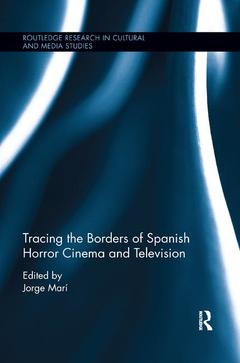Tracing the Borders of Spanish Horror Cinema and Television Routledge Research in Cultural and Media Studies Series
Coordonnateur : Marí Jorge

This critical anthology sets out to explore the boom that horror cinema and TV productions have experienced in Spain in the past two decades. It uses a range of critical and theoretical perspectives to examine a broad variety of films and filmmakers, such as works by Alejandro Amenábar, Álex de la Iglesia, Pedro Almodóvar, Guillermo del Toro, Juan Antonio Bayona, and Jaume Balagueró and Paco Plaza. The volume revolves around a set of fundamental questions: What are the causes for this new Spanish horror-mania? What cultural anxieties and desires, ideological motives and practical interests may be behind such boom? Is there anything specifically "Spanish" about the Spanish horror film and TV productions, any distinctive traits different from Hollywood and other European models that may be associated to the particular political, social, economic or cultural circumstances of contemporary Spain?
Introduction
[Jorge Marí]
Part I: The (Postmodern) Gothic
1. Trapped in The House of Mirrors: The Others as a Transnational Postmodern Gothic Thriller
[Santiago Juan-Navarro]
2. Contemporary Spanish Gothic Heroines
[Ann Davies]
Part II: Mothers, Children, Patriarchy, and the Biopolitics of Reproduction
3. Monstrous (Re)productions: Mothering Patriarchy on the Spanish Horror Screen
[Sohyun Lee]
4. Suspendido en el tiempo: Children and Contemporary Spanish Horror
[Maria Pramaggiore]
Part III: Sound, Vision, Media, and Intermediality
5. Dude, Where's My Phallus?! Locating the Horror of La piel que habito (2011)
[Samuel Amago]
6. Why They Film: The Camera and Viewer Address in Found Footage Horror Films from Spain.
[Anne E. Hardcastle]
7. Sound of Fear in Recent Spanish Films
[Martin Barnier]
Part IV: The [REC] Phenomenon
8. After the End of History: Horror Cinema in Neoliberal Spain (2002-2013)
[Víctor Pueyo]
9. Generating Fear: From Fantastic Factory (2000-2005) to [REC] (2007-2014)
[Antonio Lázaro-Reboll]
10. The Medium is the Monster: Metadiscourse and the Horrors of post-11 M Spain in the [REC] Trilogy
[William J. Nichols]
11. "I am an eye, I am a mechanichal eye ..." (The [REC] Series)
[Jean-Claude Seguin]
Part V: A Focus on Individual Filmmakers: Daniel Calparsoro and Paul Naschy
12. Blurring Reality and Fiction in Contemporary Spanish Horror TV: The Case of Daniel Calparsoro
[Vicente Rodríguez-Ortega and Rubén Romero]
13. An Icon Rises from the Grave: the 21st Century Cult Stardom of Paul Naschy
[Andy Willis]
Jorge Marí is Professor of Hispanic Studies at North Carolina State University, USA. His books include Lecturas espectaculares: el cine en la novela española desde 1970 and the co-edited volume Ventanas sobre el Atlántico: Estados Unidos-España durante el postfranquismo,1975-2008. He has published numerous essays on Spanish cultural studies, film, literature, and music.
Date de parution : 12-2019
15.2x22.9 cm
Date de parution : 04-2017
15.2x22.9 cm
Thème de Tracing the Borders of Spanish Horror Cinema and Television :
Mots-clés :
El Dia De La Bestia; El Día De La Bestia; film studies; Spanish Horror Cinema; horror film; Young Man; world film; Spanish Horror; European film; Abre Los Ojos; television studies; El Orfanato; cultural studies; Spanish Films; national cinema; El Castigo; transnational cinema; Swat Team; media studies; Found Footage Horror; Santiago Juan-Navarro; Silent House; Ann Davies; Pan’s Labyrinth; Sohyun Lee; Spanish Film Industry; Maria Pramaggiore; Horror Movies; Samuel Amago; Tv Movie; Anne E; Hardcastle; Swat; Martin Barnier; Fantastic Factory; Víctor Pueyo; La Casa Muda; Antonio Lro-Reboll; Tv Production; William J; Nichols; Apartment 143; Jean-Claude Seguin; Reality Tv; Vicente Rodríguez-Ortega; Historias Del Kronen; Rubén Romero; Found Footage Films; Andy Willis; Gothic Heroine



